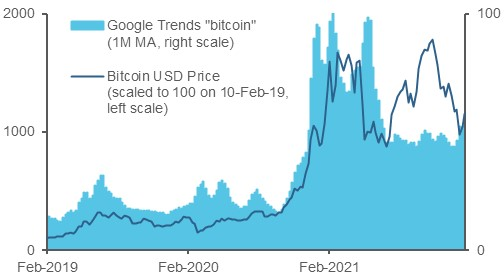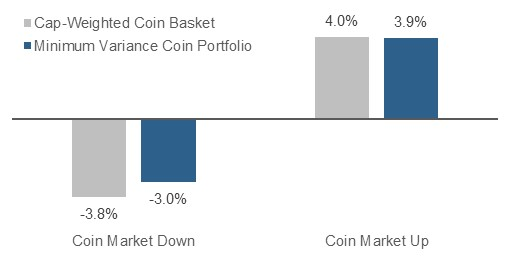Quick Take: Fortune Favors the… Boring?
Celebrities and Super Bowl ads glamorize crypto trading—at any risk
-
Bitcoin more than quintupled in 2020 and doubled again through early November of 2021 before retreating. The impressive returns attracted broad popular attention (top chart). They also caught the eye of multi-asset allocators, despite signs of rampant speculation.
-
We see the temptation of lottery-like payouts on cryptocurrencies as a major source of their appeal. To the extent that well-established coins enter the investment mainstream and behave more regularly, we expect new coins to attract risk-seekers hoping for explosive gains.
-
This affinity for risk is not new: in equities, it has driven the overpayment for high-beta stocks for decades.
Traders overpay for crypto risk, much as they do in other asset classes
-
To assess the pricing of risk in crypto markets, we conducted a simple experiment. From the most popular coins with available prices from January 2021 – February 10, 2022, we estimated a daily risk model and constructed the resulting minimum variance cryptocurrency portfolio. The portfolio exhibits a beta of roughly 0.875 relative to a cap-weighted coin basket.
-
This minimum variance portfolio outperforms in much the same way that low volatility portfolios do in other asset classes: over the sample period, it exhibited statistically significant alpha relative to the cap-weighted basket, despite the massive crypto run-up, and larger upside than downside participation (bottom chart).
-
Despite the short data history, these results suggest that crypto is yet another asset class in which risk is mispriced, a behavioral phenomenon that we observe within nearly all financial asset classes.
Surging Bitcoin Prices Attracted Search Engine Interest

Hypothetical Crypto Minimum Variance Portfolio Upside/Downside Capture

Don't miss the next Acadian Insight
Get our latest thought leadership delivered to your inbox
Hypothetical Disclosure and Legal Disclaimer
Hypothetical performance results have many inherent limitations, some of which are described below. No representation is being made that any account will or is likely to achieve profits or losses similar to those shown. In fact, there are frequently sharp differences between hypothetical performance results and the actual performance results subsequently achieved by any particular trading program.
One of the limitations of hypothetical performance results is that they are generally prepared with the benefit of hindsight. In addition, hypothetical trading does not involve financial risk, and no hypothetical trading record can completely account for the impact of financial risk in actual trading. For example, the ability to withstand losses or to adhere to a particular trading program in spite of trading losses are material points which can also adversely affect actual trading results. There are numerous other factors related to the markets in general or to the implementation of any specific trading program which cannot be fully accounted for in the preparation of hypothetical performance results and all of which can adversely affect actual trading results.
Acadian provides this material as a general overview of the firm, our processes and our investment capabilities. It has been provided for informational purposes only. It does not constitute or form part of any offer to issue or sell, or any solicitation of any offer to subscribe or to purchase, shares, units or other interests in investments that may be referred to herein and must not be construed as investment or financial product advice. Acadian has not considered any reader's financial situation, objective or needs in providing the relevant information.
The value of investments may fall as well as rise and you may not get back your original investment. Past performance is not necessarily a guide to future performance or returns. Acadian has taken all reasonable care to ensure that the information contained in this material is accurate at the time of its distribution, no representation or warranty, express or implied, is made as to the accuracy, reliability or completeness of such information.
This material contains privileged and confidential information and is intended only for the recipient/s. Any distribution, reproduction or other use of this presentation by recipients is strictly prohibited. If you are not the intended recipient and this presentation has been sent or passed on to you in error, please contact us immediately. Confidentiality and privilege are not lost by this presentation having been sent or passed on to you in error.
Acadian’s quantitative investment process is supported by extensive proprietary computer code. Acadian’s researchers, software developers, and IT teams follow a structured design, development, testing, change control, and review processes during the development of its systems and the implementation within our investment process. These controls and their effectiveness are subject to regular internal reviews, at least annual independent review by our SOC1 auditor. However, despite these extensive controls it is possible that errors may occur in coding and within the investment process, as is the case with any complex software or data-driven model, and no guarantee or warranty can be provided that any quantitative investment model is completely free of errors. Any such errors could have a negative impact on investment results. We have in place control systems and processes which are intended to identify in a timely manner any such errors which would have a material impact on the investment process.
Acadian Asset Management LLC has wholly owned affiliates located in London, Singapore, Sydney, and Tokyo. Pursuant to the terms of service level agreements with each affiliate, employees of Acadian Asset Management LLC may provide certain services on behalf of each affiliate and employees of each affiliate may provide certain administrative services, including marketing and client service, on behalf of Acadian Asset Management LLC.
Acadian Asset Management LLC is registered as an investment adviser with the U.S. Securities and Exchange Commission. Registration of an investment adviser does not imply any level of skill or training.
Acadian Asset Management (Singapore) Pte Ltd, (Registration Number: 199902125D) is licensed by the Monetary Authority of Singapore.
Acadian Asset Management (Australia) Limited (ABN 41 114 200 127) is the holder of Australian financial services license number 291872 ("AFSL"). Under the terms of its AFSL, Acadian Asset Management (Australia) Limited is limited to providing the financial services under its license to wholesale clients only. This marketing material is not to be provided to retail clients.
Acadian Asset Management (UK) Limited is authorized and regulated by the Financial Conduct Authority ('the FCA') and is a limited liability company incorporated in England and Wales with company number 05644066. Acadian Asset Management (UK) Limited will only make this material available to Professional Clients and Eligible Counterparties as defined by the FCA under the Markets in Financial Instruments Directive.